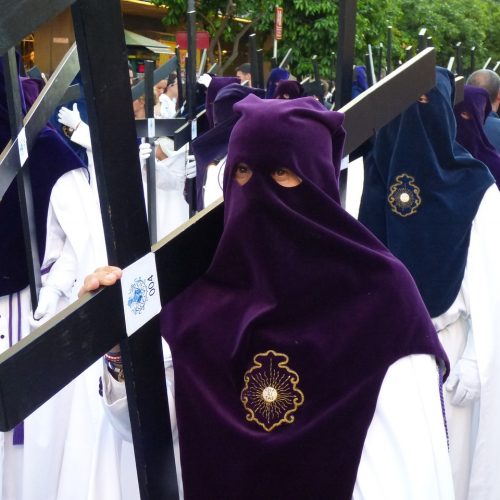
Semana Santa: Who You See in Processions
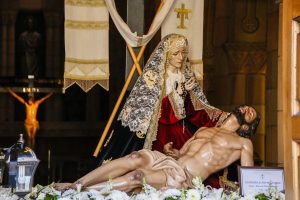 Dear Tamar,
Dear Tamar,
As you know from the introduction to Semana Santa, processions are one of the most culturally-significant traditions in Spain. During the week leading up to Easter, every city and village seems to burst to life with processions on a daily basis. While this is one of the most common forms of reverence and celebration for Spaniards, it is also one of the most unusual for many foreigners.
Note: If you are wondering if Semana Santa is happening in 2021, check out this post.
A Little Background
The first thing to keep in mind is that procesiones are defined as religious parades, which is pertinent to understanding them. In Spain, the idea of pastel-colored Easter eggs and an Easter bunny waving from a float is preposterous. Regardless of their religiosity at other times of year, Spain seems to come together to pay homage to their Catholic roots during Semana Santa and so the majority of the processions are rather solemn affairs (keep in mind that, in accordance with Catholic belief, this is the week in which Jesus was persecuted and nailed to the cross, the only real day of joy being Easter Sunday when he was resurrected). In most cities, every day of the week will be marked by at least one procession in which the religious figures on the float represent a different stage of the Passion of Christ.
While we can’t go into detail of each particular procession that happens during Semana Santa (as a reference point, there are at least four processions on 6 out of the 8 procession days in Granada alone!), we’d like to shed some light on the different elements you will notice across most, if not all, of the procesiones you come into contact with here in Spain.
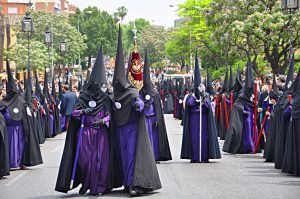 The Major Players
The Major Players
1.) Las cofradías
These are the groups, or “brotherhoods,” responsible for organizing the processions. The existence of these groups dates back to the 15th century. Still, it’s difficult to pinpoint the exact origin and if there is one cofradías in particular that can be credited with starting the tradition. The main thing to know is that, at their beginnings, these organizations were into self-flagellation or “penance” in order to live the suffering of Christ. By the 18th century, this was prohibited by the government and carrying imaginería, or the grand and detailed religious sculptures used in processions, became the new norm to show reverence for Christ. In this way, participants who carried these incredibly heavy statues could feel Christ’s pain in a more humane way.
2.) La Cruz de Guia
This is the one or two person(s) that can be found at the head of the procession, carrying the cross and guiding the rest of the participants.
3.) Nazarenos / Penitentes
Especially for those of us guiris from the US, these are the participants that really seem to catch us off guard. The cloak and cone-shaped cap that they wear are very similar to members of the Ku Klux Klan and, to be honest, did make us feel uncomfortable the first time we saw them in person. However, the traditions of nazareno’s participation in processions dates much further back than the KKK and does not have any connection once-so-ever. Instead, this clothing is meant to disguise those serving penance (hence the reason they are also known as penitentes) as well as to direct that penance up to the heavens through the capirote (cone-shaped head-covering). The outfits worn by the nazarenos also are color-coded and have different details that represent different meanings unique to the procession or the specific Church that organizes it.
Note: Historically women have ‘not been allowed’ to participate as nazarenos. However, modern day debate over this inequality has revealed that women very likely have been participating in this role for centuries, their gender disguised by the clothing. In the 21st century, official rules have been changed to include women fairly in the cofradías, but some resistance has been prevalent.
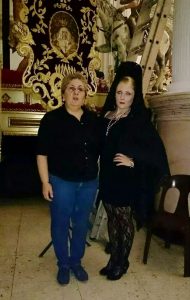 4.) Mantillas
4.) Mantillas
In contrast to being completely disguised like the nazarenos while doing their penance (i.e. walking in the processions), women tend to dress completely in black, wearing a lacey veil or, mantilla, over their heads. Their role is very similar to those of the nazarenos and they will walk together in solemn groups, some wearing incredibly high heels, others barefoot as an extreme form of penance.
5.) Hermanos de carga / Costaleros
These are the men who carry the heavy pasos*. The number of costaleros varies greatly depending on the paso, but seems to range between 30 and 150 men a piece. They will wear a special belt to protect their backs and, even so, will need to stop with relative frequency (can you imagine carrying a 1,400kg sculpture on your shoulders!?). If there is sudden clapping happening during the procession and you are uncertain why, the likely answer is that the costaleros have picked up the paso again to continue on. It is a particular honor to be selected as an hermano de carga and these participants will train all throughout the year to be ready for their role in the procesiones.
In addition to the aforementioned participants, you will also find other participants, such as those in the religious marching bands and the role you will play (along with hundreds of others) as a spectator. However, we have chosen to focus on these categories specifically as they are likely to raise the most intrigue and questions from those of us unfamiliar with these traditions.
Have you happened upon a Semana Santa procession yet? Are you looking forward to seeing a particular one? Let us know your thoughts after experiencing it!
Sincerely,
Spain
*Although the word “float” is used in English-language descriptions of Semana Santa processions, we have a very hard time using it to describe the pasos that literally weigh tons and are carried by men on foot.
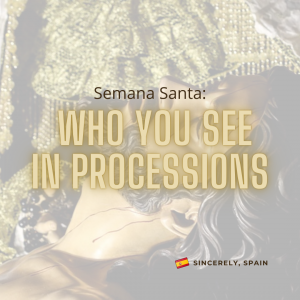 Resources in Spanish:
Resources in Spanish:
http://www.europapress.es/sociedad/noticia-cual-origen-procesiones-semana-santa-20150330145107.html
https://okdiario.com/curiosidades/2017/04/13/origen-cofradias-hermandades-semana-santa-907206
Resources in English:
https://www.thelocal.es/20180321/the-essential-guide-to-easter-in-spain
http://www.andalucia.com/festival/easter/glossary.htm



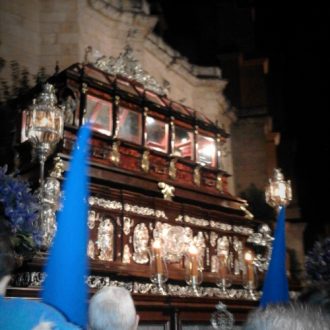

2 Comments
Elaine MacLean
I have watched many processions in Almunecar, Spain. I wonder what is being said when someone in the procession or someone close to a “float”, I believe, yells out something and the crowd responds with what sounds like “beba” or “viva”.
Sincerely, Spain
Hi Elaine, thank you for this question and apologies for our delayed response. We had a hunch, but wanted to double check our assumption before spreading false information.
What you have described is a common call-and-response that can take place between the participants and the spectators of a procession. The word is likely “viva,” which is being used in the context that we would say “long live” in English. Often, it may be the procession participants who shout out “¡Viva Jesús!” or “¡Viva la Virgen!” (in accordance with the religious figure featured on the float) and the crowd will respond with simply “¡viva!” as a means of expressing their support of the costaleros (those carrying the floats) and their devotion to the religious figure.
Hope that helps answer your question, as well as gives you confidence to take part in the collective response next time.
Sincerely,
Dani and Claudia